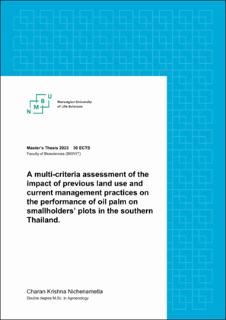| dc.description.abstract | In recent years, Southern Thailand has witnessed a surge in oil palm plantation expansion, driven primarily by smallholders who contribute over 90% of Thailand’s oil palm output. Despite their significant contribution, Thai smallholders have consistently achieved lower yields compared to counterparts in Indonesia and Malaysia. To address this challenge, the DYNAMOST project (2022-2023) was initiated to investigate land use changes and assess smallholder management practices in South-ern Thailand. The project was structured into three work packages (WP). WP1 examined recent changes in oil palm cultivation in Southern Thailand, mapping these changes alongside historical land use dynamics over the past decade. WP2 focused on specific zones to understand smallholders’ trajectories and the factors driving these changes. Finally, WP3, which encompasses my thesis, aimed to conduct a comprehensive analysis integrating smallholders’ yield gaps and bottlenecks to provide valuable recommendations for implementing best management practices in the region.
Management practices, primarily related to fertilizer application intensity, characterized different groups of farmers in the study area. Notably, an average farmer applied less fertilizer than Thai Good Agricultural Practices (GAP) recommendations. The most optimal fertilizer use is observed for a cluster of farmers, who consistently produced higher quantity than their counterparts, particularly in June. Oil extraction rates varied between 23% to 35%, with the highest mean value achieved in young plantations (< 7 years). Additionally, the study highlights the significant influence of previous land use type on production performance. Replanted oil palms demonstrate relatively higher oil extraction efficiency than other land use changes. The transition from rice to oil palm cultivation has a notable effect on soil quality, influencing palm growth (low K/Mg and Ca/Mg) and production quantity. Therefore, it is crucial to consider balanced soil nutrient levels for plantations with a history of rice cultivation. Our findings further emphasize the need for improving several practices. These include optimal use of fertilizers, maintaining more fronds (>32) per palm during pruning, regular pest monitoring and recording of resource use and sales data for fresh fruit bunches. Furthermore, having good knowledge of the planting material is crucial for production performance. | |
